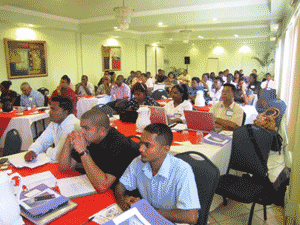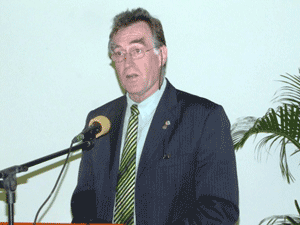REGIONAL Health Officers and Programme Heads Wednesday met for their second biennial meeting at the Grand Coastal Inn, East Coast Demerara, to focus on the development of the 2013-2020 Health Strategy entitled “Health Vision 2020”.
 The new plan replaces the old one which concludes at the end of 2012, and envisions Guyanese as the healthiest people in the Caribbean and Latin America.
The new plan replaces the old one which concludes at the end of 2012, and envisions Guyanese as the healthiest people in the Caribbean and Latin America.
The meeting took the format of being more of a stakeholder consultation than the usual reporting session, and follows another consultation held recently that targeted top officials in the health sector and support agencies.
Minister of Health, Dr. Bheri Ramsaran in his address, highlighted that the strategy looks at the needs of the health sector and, in turn, the provision of same to the public.
Minister Ramsaran stated that the new strategic plan puts Non-Communicable Diseases on the front burner, and desires a cross-sectoral approach, including the Ministries of Education and Local Government and Regional Development.
He illustrated that the Education Ministry’s canteen policy, for instance, has some amount of input from the Health Ministry in the area of ensuring the food is prepared in a safe and healthy environment.
The Ministry of Local Government has a Health Coordinator looking over the delivery of health care in the regions. With these partnerships in mind, Minister Ramsaran is calling for stronger synergies among the ministries in order to get the best results in the overall delivery of health care in Guyana.
The minister also highlighted that it has been recognised internationally that Non-Communicable Diseases (NCDs) have an impact on the development of many countries; as such much attention is being placed on this epidemic. He recalled that a few years ago, HIV/AIDS stood in the same position NCDs now stand; however, due to intense responses, the battle against HIV/AIDS has been successful; no less a result is expected with NCDs. Permanent Secretary, Leslie Cadogan, emphasised that the plan brings into focus the achievement of the Millennium Development Goals (MDGs) by 2015. He posited that having the input from the regional health authorities is important, since they are the ones who engage with the citizens in their respective regions.
Permanent Secretary, Leslie Cadogan, emphasised that the plan brings into focus the achievement of the Millennium Development Goals (MDGs) by 2015. He posited that having the input from the regional health authorities is important, since they are the ones who engage with the citizens in their respective regions.
He indicated that the Health Ministry recognises that it cannot make all the decisions, regarding the plan alone, hence the need for all stakeholders to contribute in one way or another since they have value for the national effort.
Stakeholder participation is also important due to the fact that the decisions being made impact the nation’s health, and in the long-term, national development. Additionally, the stakeholders bring to the fore the feasibility and practicality in the implementation of the strategy.
PAHO/WHO Representative Adrianus Vlugman noted that Phase 1 of the project covers the next three years, and the name change from National Health Strategy to Health Vision 2020 reflects the realisation that health is a broad developmental concept which is impacted upon by drivers beyond the directive of the Health Ministry.
He stated that the strategy is being developed with broad consultation with health sector professionals, the private sector, development partners and other ministries. The first stakeholder consultation was held in October at Baganara.
Dr. Vlugman pointed out that the strategy will also address ethnicity and culture, gender, specific issues and gender-based violence. He highlighted that the implementation of the strategy will take a bottom-up approach with a three- year consolidation period which focuses on improving access to quality of service among the marginalised and hinterland communities. Vision 2020 will be a road map that will provide strategic direction in the delivery of health services.
He highlighted that the implementation of the strategy will take a bottom-up approach with a three- year consolidation period which focuses on improving access to quality of service among the marginalised and hinterland communities. Vision 2020 will be a road map that will provide strategic direction in the delivery of health services.
Chief Medical Officer, Dr. Shamdeo Persaud made the first presentation regarding the 2020 Plan, which he outlined, is guided by the MDGs, Nassau Declaration on Health, Caribbean Cooperation in Health III, Port of Spain Declaration/United National High Level Meeting on NCDs and the National Development Strategy/Low Carbon Development Strategy (LCDS).
The strategy targets increased life expectancy for both men and women to over 70 years, decrease in maternal mortality to below 80 for 100,000 live births, decrease in infant and child mortality to less than 14 and 16 per 10,000 live births, decrease by 25 percent in the mortality of cardiovascular disease, cancer, diabetes and lung disease, reduce by 25 percent the impact of smoking, harmful use of alcohol, physical inactivity and unhealthy diet, reduce the risk and decrease incidences and prevalence of communicable diseases such as HIV, tuberculosis, and malaria.
Dr. Persaud noted that the plan has two strategic pillars, which are universal health coverage and social determinants of health. The building blocks of the plan are influenced by factors set by the World Health Organisation (WHO), and take into consideration service delivery, health workforce, information/surveillance, medical products, vaccines and technology and financing and leadership.
Some of the new strategic components included improved governance reorganising the delivery of health, application of evidence-based approaches, capacity building, strengthening health sector financing, strengthening strategic information for planning and implementation, and developing performance management and monitoring systems.
Priority areas include family health, NCDs, human resources, communicable diseases, environmental health, accident responses, frontier, migrant, remote and vulnerable population, advance health care and health literacy. (GINA)




.png)









